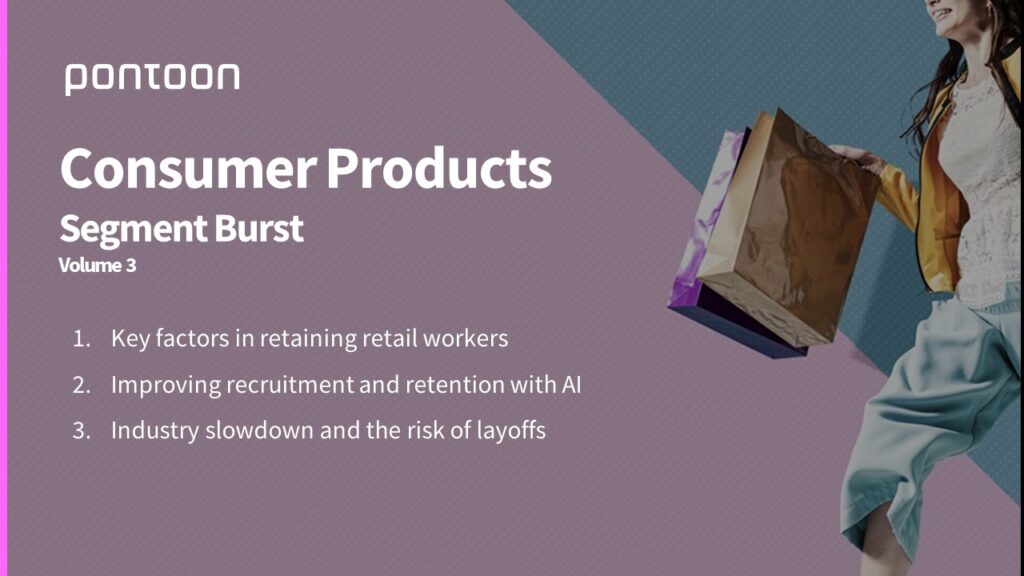Consumer Products and Retail Segment Burst: Vol 3
Research
.
In the third volume of Consumer Products and Retail Segment Burst we explore the most recent trends in the sector.
-
What are the key factors in retaining retail workers?
-
How can artificial intelligence improve recruitment and retention in the consumer products industry?
-
Is the industry experiencing a slowdown and are layoffs inevitable?
Read on to find out.
Key factors in retaining retail workers
Despite recent improvements, grocery retail – a growing segment that employs over 8.5 million people in the US and EU – continues to face challenges. Worker retention issues remain an overwhelming concern. 76% of retail workers who quit their jobs in the last two years have not returned to the industry.
To attract and retain talent in a competitive labour market, retailers should consider the following factors.
Flexibility: According to McKinsey, retail is the only industry in which the lack of flexibility is the number one driver for quitting one’s job. For retail workers, flexibility means predictable schedules, regular hours, and the opportunity to choose days worked. Workers crave autonomy and control, which often leads to increased job satisfaction and engagement at work.
Career growth: The retail model is shifting, as physical and manual skills are expected to become less relevant with automation and digitisation. Technology skills in retail are expected to become 64% more important by 2030. To address these changing needs, companies should provide long-term reskilling and upskilling initiatives as part of their larger workforce plan.
Worker experience: While pay and benefits are always important, workers also want to feel valued and part of the team. Engaged workers are more productive and less likely to look for another job. Consider re-evaluating your company’s recognition programmes, performance evaluation system, and internal promotion policy. Making people feel appreciated is the easiest way to mitigate the risk of short-term attrition.
Understanding the needs of workers and developing an EVP with employees in mind creates a culture of trust, raises productivity, and plays a key role in preventing attrition. Investing in flexible options, improving career progress opportunities, and considering workers’ wellbeing can help strengthen your business and increase retention.
Improving recruitment and retention with AI
The consumer goods industry has faced significant challenges in the past few years. The pandemic and supply chain volatility have forced companies to adjust their business strategies. Now, with a looming recession, high attrition rates, and increased hiring and training costs, businesses need to explore new technologies to improve recruitment and increase retention.
How can AI support consumer products and retail companies with recruitment? AI can take the guesswork out of the process. With well-designed interactive surveys and questionnaires, the application process can more accurately identify potential candidates and assess a candidate’s fit within company culture, leading to a less biased recruiting decision. AI can consider transferrable skills, further widening the candidate pool.
For retention, AI can be used to analyse employee performance and identify the need for new learning and development initiatives to improve career progression and prevent stagnation. It can also be used as a predictive model of engagement to determine levels of employee satisfaction.
With so many potential benefits, it’s no surprise that over half (55%) of the global workforce say that they would be more likely to stay with a company if their employer would use AI to aid their career growth. In fact, 82% of workers believe that AI can support career growth better than humans.
Improving recruitment and committing to your employees’ career development is critical for business growth. Workers are open to innovation and adopting new technology, yet fewer than half of employees say that their company uses AI in the workplace. Early adoption of AI can set your company apart as being more innovative and supportive of your employees’ needs, putting you on a path to future-proofing your business and acquiring a highly skilled workforce.
Industry slowdown and the risk of layoffs
Price inflation has skyrocketed across the globe. In the UK, grocery inflation accelerated to an all-time high of 13.9% in September 2022. The increase has reached the highest level since Kantar started tracking grocery prices in 2008.
The US has seen a 10.9% increase since August 2021, the largest increase in over 40 years. And the inflation rate for food in the EU reached 15.4% in August 2022.
With prices going up due to inflation, consumers are changing their buying habits. This change is being felt most heavily by producers of brand-name and specialty food who are forced to introduce cost-cutting measures, including layoffs.
Impossible Foods, a plant-based meat company, recently laid off 6% of its workforce as part of a reorganisation. Though the company reports steady growth, they have considered recent economic factors and are prioritising initiatives to strengthen their operation and prepare for the future.
Planterra, another plant-based meat producer, is shutting down operations this year, laying off 121 employees in their corporate headquarters and manufacturing plant.
Beyond Meat is laying off 19% of its workforce after a year of stagnant growth.
As the current economic situation raises concerns across all segments, employers are facing difficult decisions when it comes to making short-term and long-term plans.
Firms should carefully consider when, how, and if they should let workers go. Though layoffs might appear to be an easy solution to maintain market competitiveness, they do not come without costs – severance allowance or continued benefits might follow.
Layoffs can also cause stress for remaining employees, damaging team morale. They might bring higher turnover than expected as some employees choose to abandon ship
for fear of continued workforce reductions. It can be difficult for a company to recover from losing too much well-trained talent, and laid-off workers are unlikely to accept a rehire offer once the company’s financial situation improves.
Staying competitive while handling short-term disruptions and planning long-term strategies is not easy. Before making the decision to lay off workers, weigh all possible options and consider the ramifications of any decision you make.
Related Post
How circular value pools can drive employee attraction and retention in the European FMCG industry?
Why distribution centres are being replaced by in-store fulfilment models and how to address seasonal hiring ...





